Design of LMS based adaptive beamformer for ULA antennas
This paper proposes a design of an adaptive beamformer for arbitrarily Uniformly spaced Linear Array
(ULA) antennas. Least Mean Square (LMS), a prevalent adaptive beamforming algorithm, has been employed in
the beamformer for the ULA antennas. A procedure has been introduced to validate the proposed design.
Applying the proposal, a LMS based adaptive beamformer for 8×1 ULA antennas has been built and
implemented on Xilinx FPGA. The fundamental characteristics of the implemented beamformer have been
measured and verified. The experimental results show that the beamformer is capable of creating appropriate
weights in order to steer the main lobe of the ULA antennas to the desired direction and to place simultaneously
null points towards the interferences in case of NOAA LEO satellites system.
Received 01 October 2016, Revised 16 November 2016, Accepted 19 November 2016
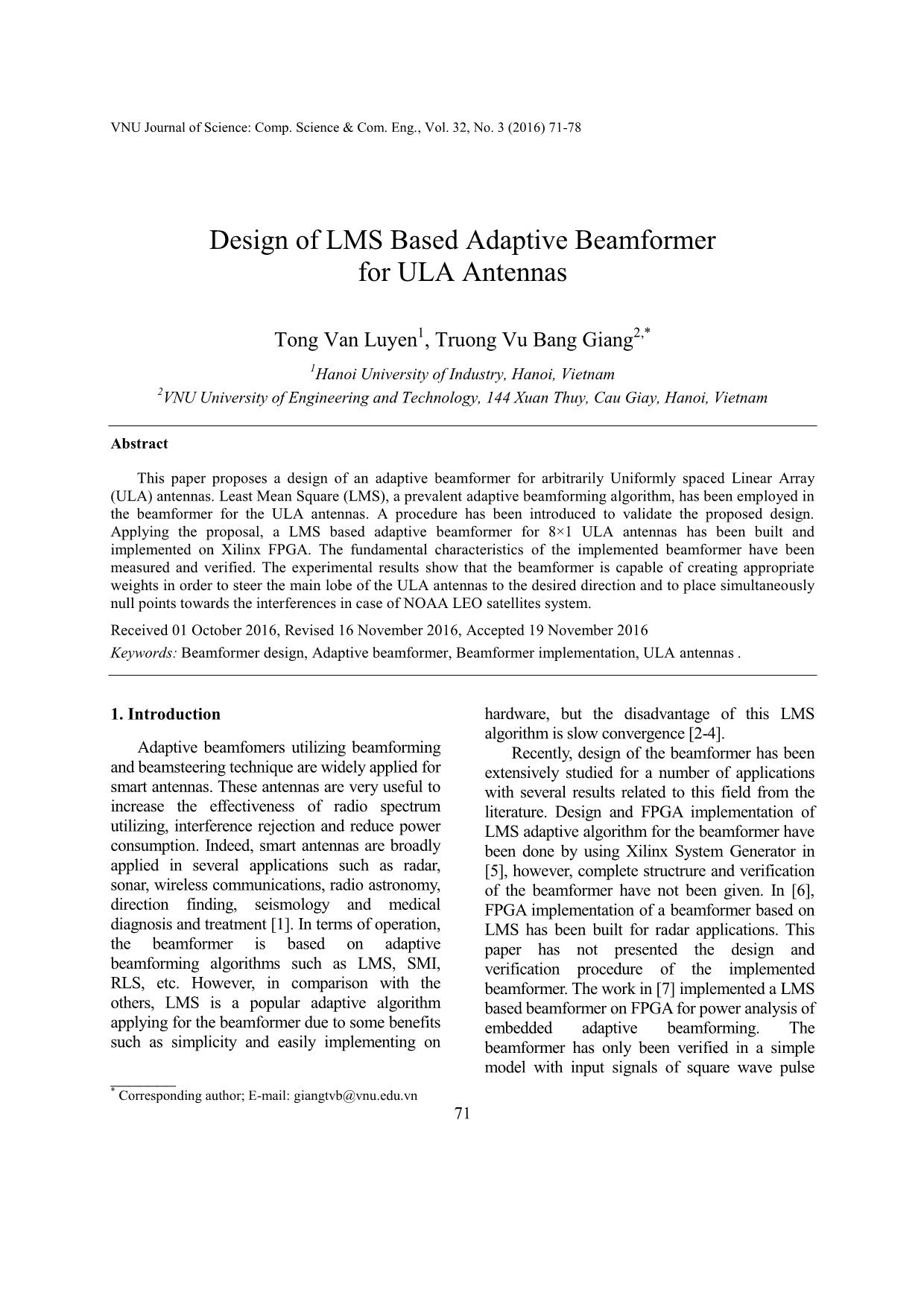
Trang 1
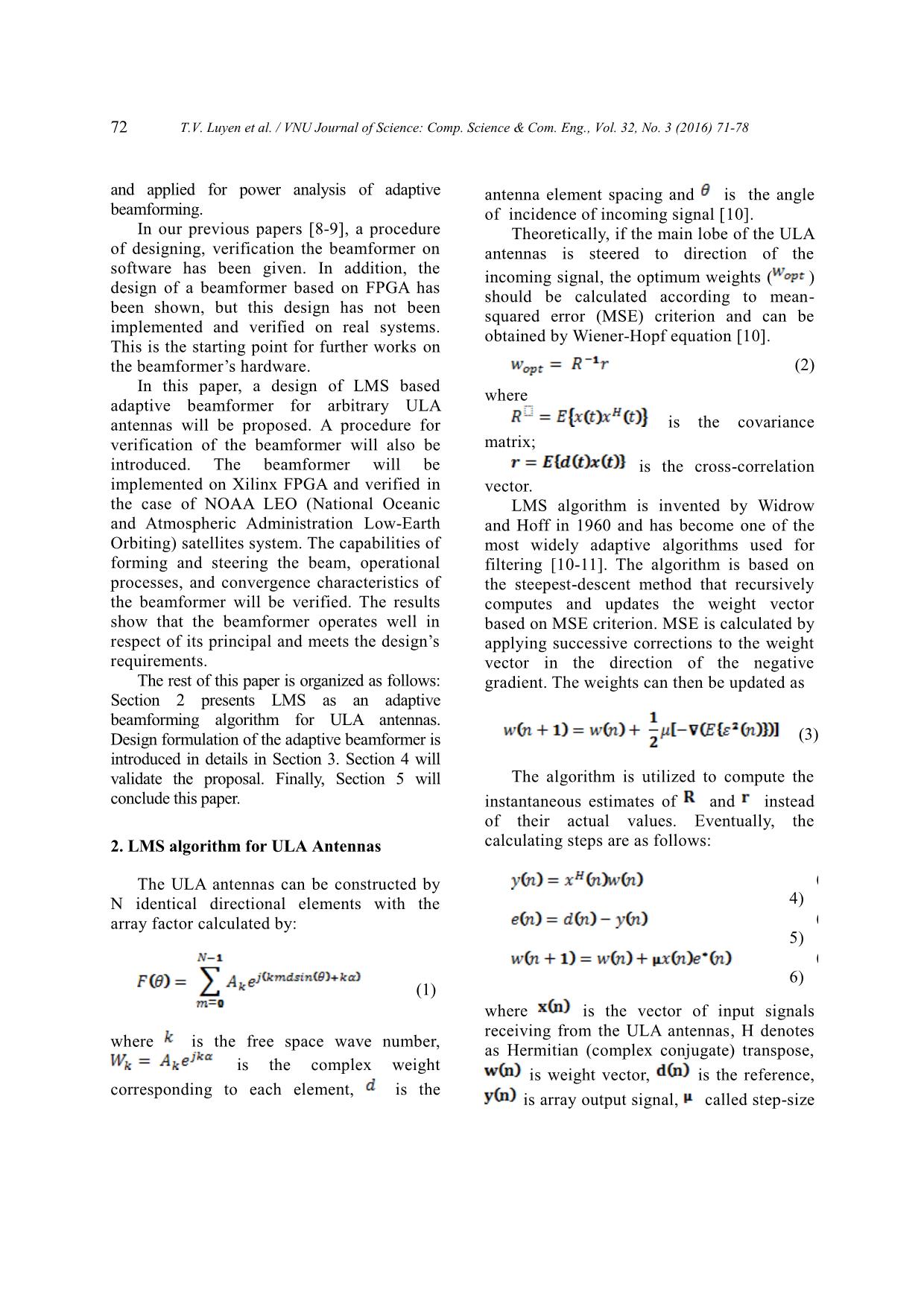
Trang 2
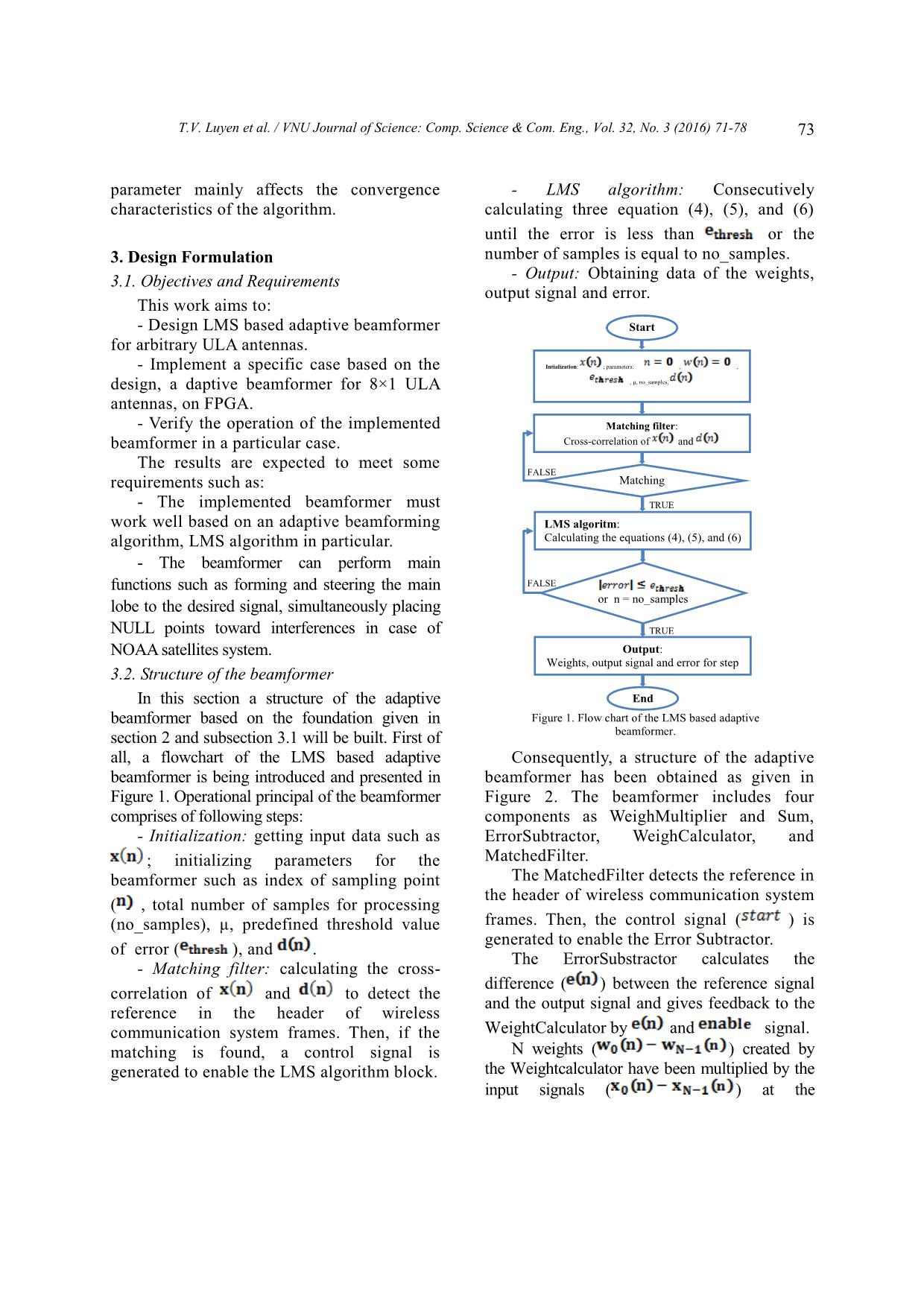
Trang 3
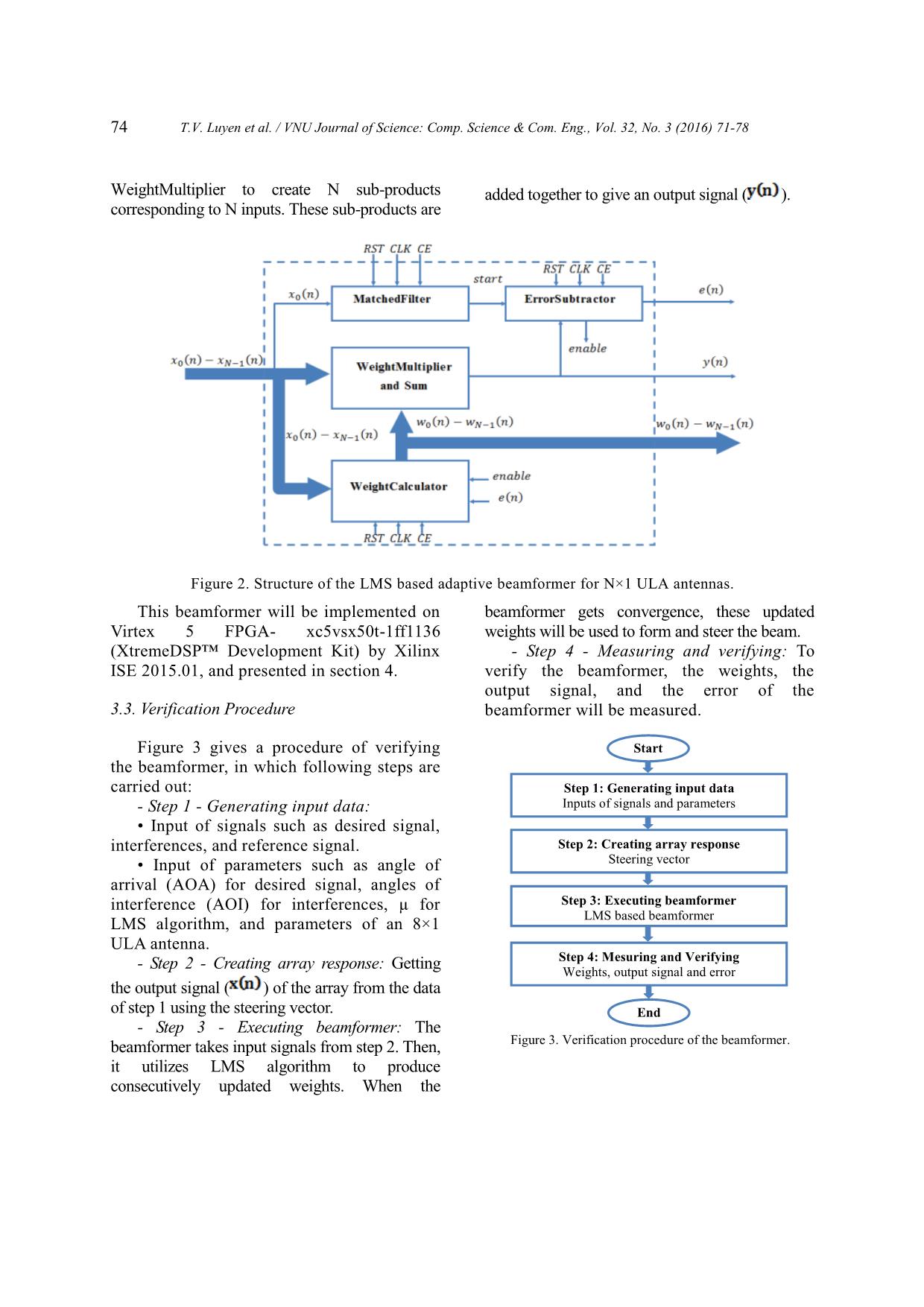
Trang 4
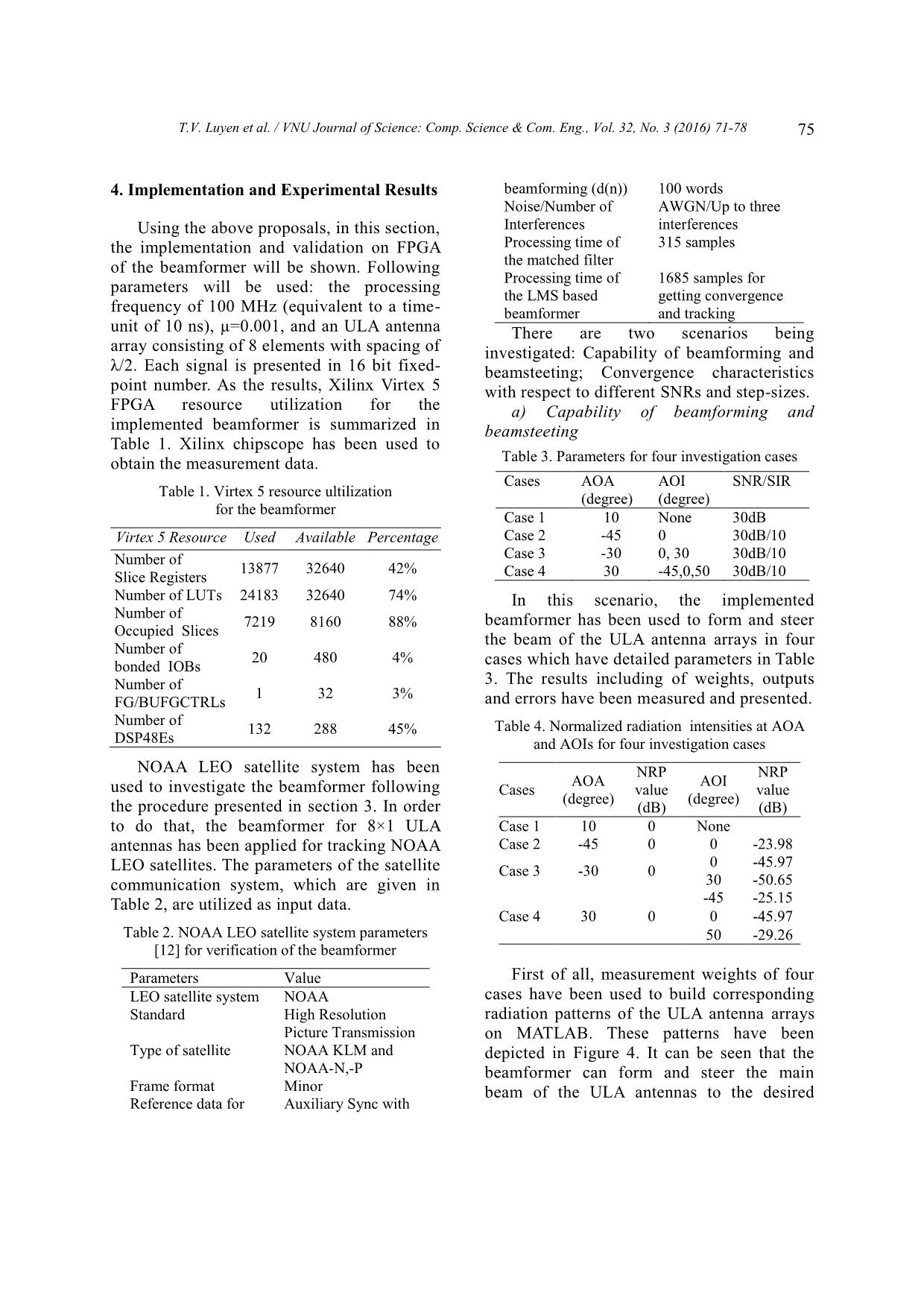
Trang 5
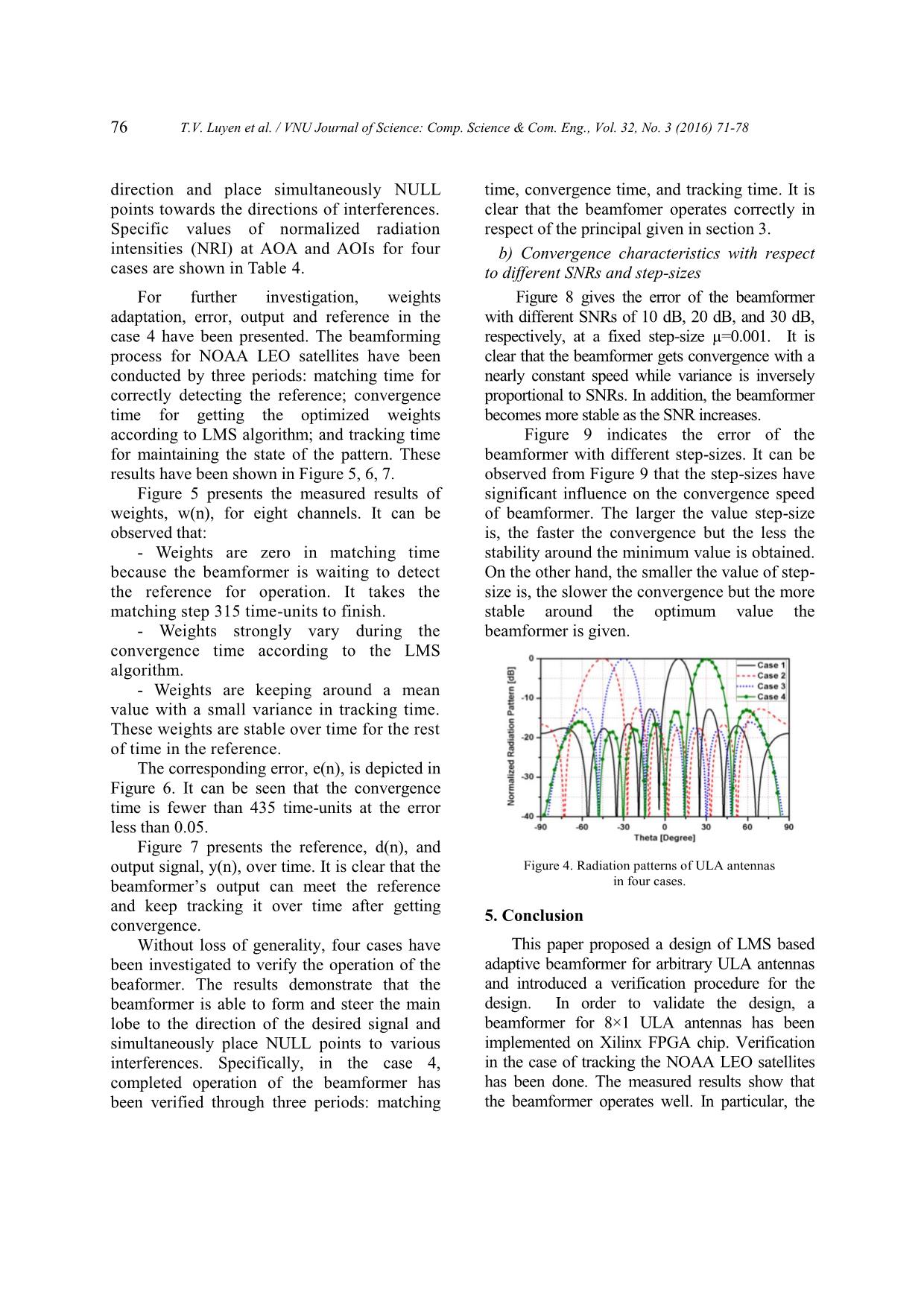
Trang 6
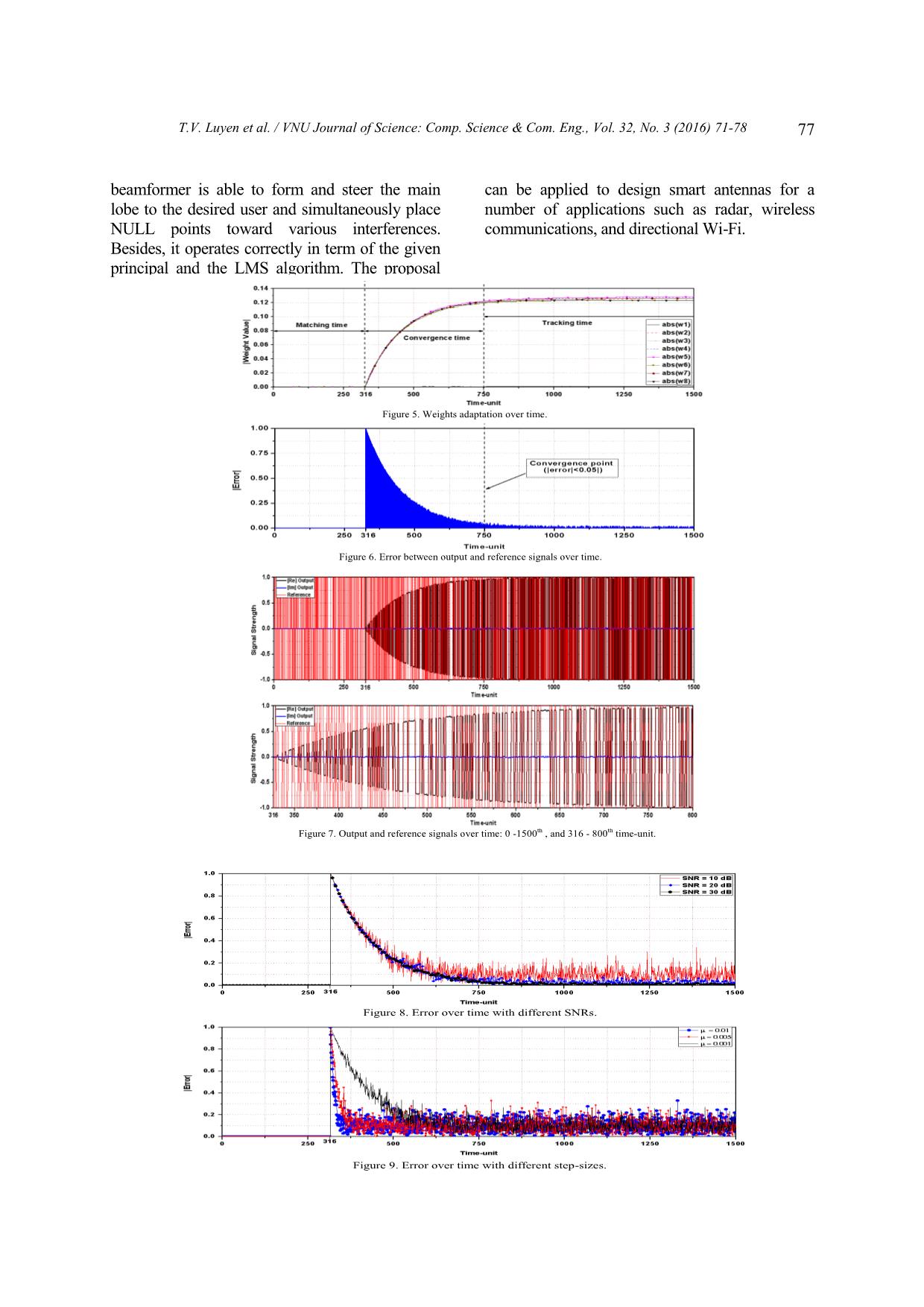
Trang 7
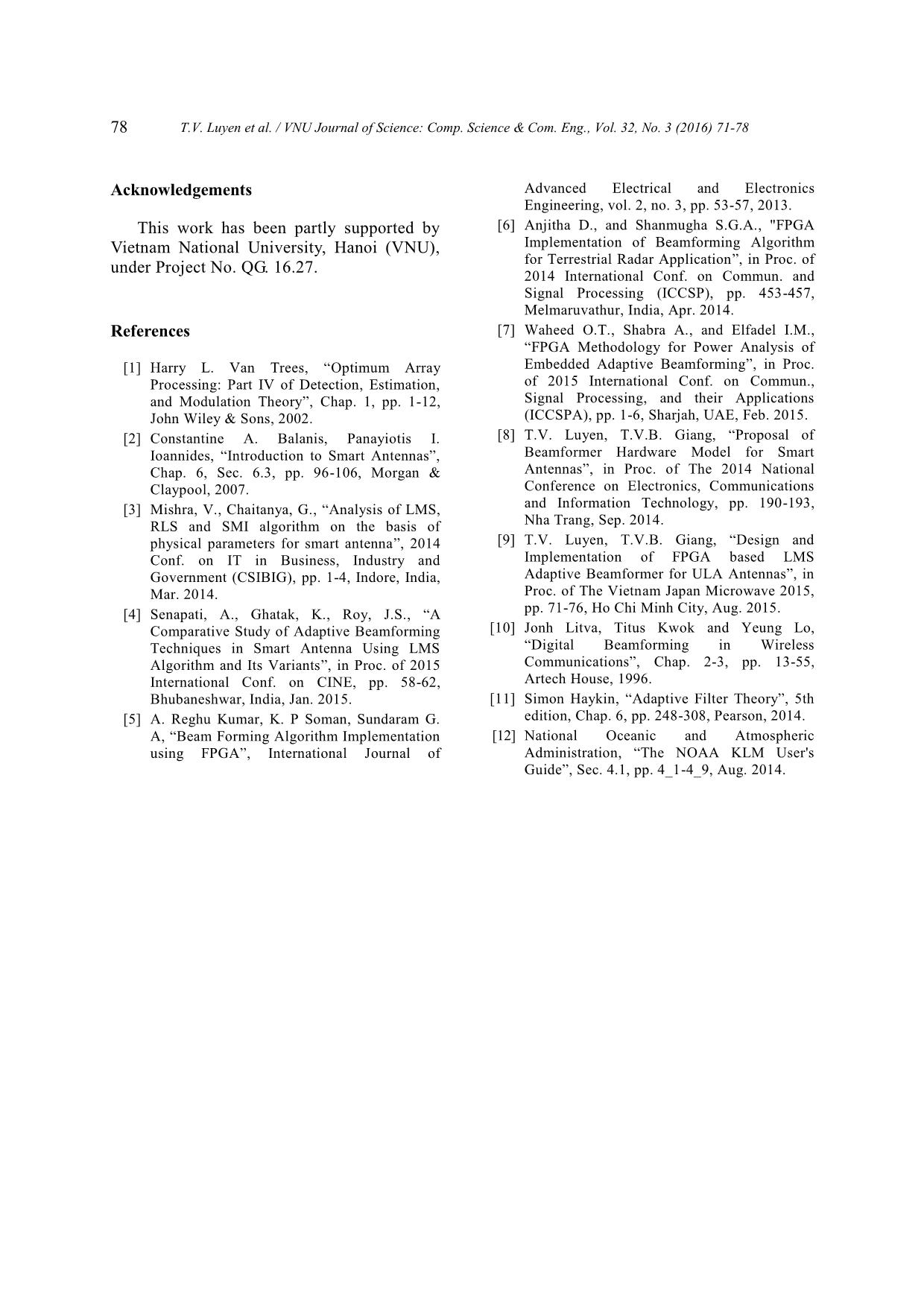
Trang 8
Tóm tắt nội dung tài liệu: Design of LMS based adaptive beamformer for ULA antennas
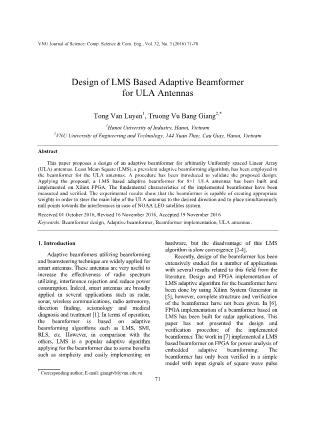
ze T.V. Luyen et al. / VNU Journal of Science: Comp. Science & Com. Eng., Vol. 32, No. 3 (2016) 71-78 73 parameter mainly affects the convergence - LMS algorithm: Consecutively characteristics of the algorithm. calculating three equation (4), (5), and (6) until the error is less than or the 3. Design Formulation number of samples is equal to no_samples. 3.1. Objectives and Requirements - Output: Obtaining data of the weights, output signal and error. This work aims to: - Design LMS based adaptive beamformer Start \ for arbitrary ULA antennas. - Implement a specific case based on the Intialization: ; parameters: , , design, a daptive beamformer for 8×1 ULA , µ, no_samples, antennas, on FPGA. - Verify the operation of the implemented Matching filter: beamformer in a particular case. Cross-correlation of and The results are expected to meet some FALSE requirements such as: Matching - The implemented beamformer must TRUE work well based on an adaptive beamforming LMS algoritm: algorithm, LMS algorithm in particular. Calculating the equations (4), (5), and (6) - The beamformer can perform main functions such as forming and steering the main FALSE or n = no_samples lobe to the desired signal, simultaneously placing NULL points toward interferences in case of TRUE NOAA satellites system. Output: Weights, output signal and error for step 3.2. Structure of the beamformer 4 In this section a structure of the adaptive End beamformer based on the foundation given in Figure 1. Flow chart of the LMS based adaptive section 2 and subsection 3.1 will be built. First of beamformer. all, a flowchart of the LMS based adaptive Consequently, a structure of the adaptive beamformer is being introduced and presented in beamformer has been obtained as given in Figure 1. Operational principal of the beamformer Figure 2. The beamformer includes four comprises of following steps: components as WeighMultiplier and Sum, - Initialization: getting input data such as ErrorSubtractor, WeighCalculator, and ; initializing parameters for the MatchedFilter. beamformer such as index of sampling point The MatchedFilter detects the reference in the header of wireless communication system ( , total number of samples for processing (no_samples), µ, predefined threshold value frames. Then, the control signal ( ) is generated to enable the Error Subtractor. of error ( ), and . The ErrorSubstractor calculates the - Matching filter: calculating the cross- difference ( ) between the reference signal correlation of and to detect the and the output signal and gives feedback to the reference in the header of wireless communication system frames. Then, if the WeightCalculator by and signal. matching is found, a control signal is N weights ( ) created by generated to enable the LMS algorithm block. the Weightcalculator have been multiplied by the input signals ( ) at the 74 T.V. Luyen et al. / VNU Journal of Science: Comp. Science & Com. Eng., Vol. 32, No. 3 (2016) 71-78 WeightMultiplier to create N sub-products added together to give an output signal ( ). corresponding to N inputs. These sub-products are e Figure 2. Structure of the LMS based adaptive beamformer for N×1 ULA antennas. This beamformer will be implemented on beamformer gets convergence, these updated Virtex 5 FPGA- xc5vsx50t-1ff1136 weights will be used to form and steer the beam. (XtremeDSP™ Development Kit) by Xilinx - Step 4 - Measuring and verifying: To ISE 2015.01, and presented in section 4. verify the beamformer, the weights, the output signal, and the error of the 3.3. Verification Procedure beamformer will be measured. Figure 3 gives a procedure of verifying Start the beamformer, in which following steps are carried out: Step 1: Generating input data Inputs of signals and parameters - Step 1 - Generating input data: • Input of signals such as desired signal, interferences, and reference signal. Step 2: Creating array response Steering vector • Input of parameters such as angle of arrival (AOA) for desired signal, angles of interference (AOI) for interferences, µ for Step 3: Executing beamformer LMS based beamformer LMS algorithm, and parameters of an 8×1 ULA antenna. - Step 2 - Creating array response: Getting Step 4: Mesuring and Verifying Weights, output signal and error the output signal ( ) of the array from the data of step 1 using the steering vector. End - Step 3 - Executing beamformer: The beamformer takes input signals from step 2. Then, Figure 3. Verification procedure of the beamformer. it utilizes LMS algorithm to produce consecutively updated weights. When the T.V. Luyen et al. / VNU Journal of Science: Comp. Science & Com. Eng., Vol. 32, No. 3 (2016) 71-78 75 4. Implementation and Experimental Results beamforming (d(n)) 100 words Noise/Number of AWGN/Up to three Using the above proposals, in this section, Interferences interferences the implementation and validation on FPGA Processing time of 315 samples of the beamformer will be shown. Following the matched filter Processing time of 1685 samples for parameters will be used: the processing the LMS based getting convergence frequency of 100 MHz (equivalent to a time- beamformer and tracking unit of 10 ns), µ=0.001, and an ULA antenna There are two scenarios being array consisting of 8 elements with spacing of investigated: Capability of beamforming and λ/2. Each signal is presented in 16 bit fixed- beamsteeting; Convergence characteristics point number. As the results, Xilinx Virtex 5 with respect to different SNRs and step-sizes. FPGA resource utilization for the a) Capability of beamforming and implemented beamformer is summarized in beamsteeting Table 1. Xilinx chipscope has been used to obtain the measurement data. Table 3. Parameters for four investigation cases Cases AOA AOI SNR/SIR Table 1. Virtex 5 resource ultilization (degree) (degree) for the beamformer Case 1 10 None 30dB Virtex 5 Resource Used Available Percentage Case 2 -45 0 30dB/10 Number of Case 3 -30 0, 30 30dB/10 13877 32640 42% Slice Registers Case 4 30 -45,0,50 30dB/10 Number of LUTs 24183 32640 74% In this scenario, the implemented Number of 7219 8160 88% beamformer has been used to form and steer Occupied Slices the beam of the ULA antenna arrays in four Number of 20 480 4% bonded IOBs cases which have detailed parameters in Table Number of 3. The results including of weights, outputs 1 32 3% FG/BUFGCTRLs and errors have been measured and presented. Number of 132 288 45% Table 4. Normalized radiation intensities at AOA DSP48Es and AOIs for four investigation cases NOAA LEO satellite system has been NRP NRP AOA AOI used to investigate the beamformer following Cases value value (degree) (degree) the procedure presented in section 3. In order (dB) (dB) to do that, the beamformer for 8×1 ULA Case 1 10 0 None antennas has been applied for tracking NOAA Case 2 -45 0 0 -23.98 0 -45.97 LEO satellites. The parameters of the satellite Case 3 -30 0 communication system, which are given in 30 -50.65 Table 2, are utilized as input data. -45 -25.15 Case 4 30 0 0 -45.97 Table 2. NOAA LEO satellite system parameters 50 -29.26 [12] for verification of the beamformer Parameters Value First of all, measurement weights of four LEO satellite system NOAA cases have been used to build corresponding Standard High Resolution radiation patterns of the ULA antenna arrays Picture Transmission on MATLAB. These patterns have been Type of satellite NOAA KLM and depicted in Figure 4. It can be seen that the NOAA-N,-P beamformer can form and steer the main Frame format Minor beam of the ULA antennas to the desired Reference data for Auxiliary Sync with 76 T.V. Luyen et al. / VNU Journal of Science: Comp. Science & Com. Eng., Vol. 32, No. 3 (2016) 71-78 direction and place simultaneously NULL time, convergence time, and tracking time. It is points towards the directions of interferences. clear that the beamfomer operates correctly in Specific values of normalized radiation respect of the principal given in section 3. intensities (NRI) at AOA and AOIs for four b) Convergence characteristics with respect cases are shown in Table 4. to different SNRs and step-sizes For further investigation, weights Figure 8 gives the error of the beamformer adaptation, error, output and reference in the with different SNRs of 10 dB, 20 dB, and 30 dB, case 4 have been presented. The beamforming respectively, at a fixed step-size µ=0.001. It is process for NOAA LEO satellites have been clear that the beamformer gets convergence with a conducted by three periods: matching time for nearly constant speed while variance is inversely correctly detecting the reference; convergence proportional to SNRs. In addition, the beamformer time for getting the optimized weights becomes more stable as the SNR increases. according to LMS algorithm; and tracking time Figure 9 indicates the error of the for maintaining the state of the pattern. These beamformer with different step-sizes. It can be results have been shown in Figure 5, 6, 7. observed from Figure 9 that the step-sizes have Figure 5 presents the measured results of significant influence on the convergence speed weights, w(n), for eight channels. It can be of beamformer. The larger the value step-size observed that: is, the faster the convergence but the less the - Weights are zero in matching time stability around the minimum value is obtained. because the beamformer is waiting to detect On the other hand, the smaller the value of step- the reference for operation. It takes the size is, the slower the convergence but the more matching step 315 time-units to finish. stable around the optimum value the - Weights strongly vary during the beamformer is given. convergence time according to the LMS algorithm. - Weights are keeping around a mean value with a small variance in tracking time. These weights are stable over time for the rest of time in the reference. The corresponding error, e(n), is depicted in Figure 6. It can be seen that the convergence time is fewer than 435 time-units at the error less than 0.05. Figure 7 presents the reference, d(n), and output signal, y(n), over time. It is clear that the Figure 4. Radiation patterns of ULA antennas in four cases. beamformer’s output can meet the reference and keep tracking it over time after getting 5. Conclusion convergence. Without loss of generality, four cases have This paper proposed a design of LMS based been investigated to verify the operation of the adaptive beamformer for arbitrary ULA antennas beaformer. The results demonstrate that the and introduced a verification procedure for the beamformer is able to form and steer the main design. In order to validate the design, a lobe to the direction of the desired signal and beamformer for 8×1 ULA antennas has been simultaneously place NULL points to various implemented on Xilinx FPGA chip. Verification interferences. Specifically, in the case 4, in the case of tracking the NOAA LEO satellites completed operation of the beamformer has has been done. The measured results show that been verified through three periods: matching the beamformer operates well. In particular, the T.V. Luyen et al. / VNU Journal of Science: Comp. Science & Com. Eng., Vol. 32, No. 3 (2016) 71-78 77 beamformer is able to form and steer the main can be applied to design smart antennas for a lobe to the desired user and simultaneously place number of applications such as radar, wireless NULL points toward various interferences. communications, and directional Wi-Fi. Besides, it operates correctly in term of the given F principal and the LMS algorithm. The proposal F Figure 5. Weights adaptation over time. Figure 6. Error between output and reference signals over time. Figure 7. Output and reference signals over time: 0 -1500th , and 316 - 800th time-unit. H Figure 8. Error over time with different SNRs. Figure 9. Error over time with different step-sizes. 78 T.V. Luyen et al. / VNU Journal of Science: Comp. Science & Com. Eng., Vol. 32, No. 3 (2016) 71-78 Acknowledgements Advanced Electrical and Electronics Engineering, vol. 2, no. 3, pp. 53-57, 2013. This work has been partly supported by [6] Anjitha D., and Shanmugha S.G.A., "FPGA Vietnam National University, Hanoi (VNU), Implementation of Beamforming Algorithm under Project No. QG. 16.27. for Terrestrial Radar Application”, in Proc. of 2014 International Conf. on Commun. and Signal Processing (ICCSP), pp. 453-457, Melmaruvathur, India, Apr. 2014. References [7] Waheed O.T., Shabra A., and Elfadel I.M., “FPGA Methodology for Power Analysis of [1] Harry L. Van Trees, “Optimum Array Embedded Adaptive Beamforming”, in Proc. Processing: Part IV of Detection, Estimation, of 2015 International Conf. on Commun., and Modulation Theory”, Chap. 1, pp. 1-12, Signal Processing, and their Applications John Wiley & Sons, 2002. (ICCSPA), pp. 1-6, Sharjah, UAE, Feb. 2015. [2] Constantine A. Balanis, Panayiotis I. [8] T.V. Luyen, T.V.B. Giang, “Proposal of Ioannides, “Introduction to Smart Antennas”, Beamformer Hardware Model for Smart Chap. 6, Sec. 6.3, pp. 96-106, Morgan & Antennas”, in Proc. of The 2014 National Claypool, 2007. Conference on Electronics, Communications [3] Mishra, V., Chaitanya, G., “Analysis of LMS, and Information Technology, pp. 190-193, RLS and SMI algorithm on the basis of Nha Trang, Sep. 2014. physical parameters for smart antenna”, 2014 [9] T.V. Luyen, T.V.B. Giang, “Design and Conf. on IT in Business, Industry and Implementation of FPGA based LMS Government (CSIBIG), pp. 1-4, Indore, India, Adaptive Beamformer for ULA Antennas”, in Mar. 2014. Proc. of The Vietnam Japan Microwave 2015, [4] Senapati, A., Ghatak, K., Roy, J.S., “A pp. 71-76, Ho Chi Minh City, Aug. 2015. Comparative Study of Adaptive Beamforming [10] Jonh Litva, Titus Kwok and Yeung Lo, Techniques in Smart Antenna Using LMS “Digital Beamforming in Wireless Algorithm and Its Variants”, in Proc. of 2015 Communications”, Chap. 2-3, pp. 13-55, International Conf. on CINE, pp. 58-62, Artech House, 1996. Bhubaneshwar, India, Jan. 2015. [11] Simon Haykin, “Adaptive Filter Theory”, 5th [5] A. Reghu Kumar, K. P Soman, Sundaram G. edition, Chap. 6, pp. 248-308, Pearson, 2014. A, “Beam Forming Algorithm Implementation [12] National Oceanic and Atmospheric using FPGA”, International Journal of Administration, “The NOAA KLM User's Guide”, Sec. 4.1, pp. 4_1-4_9, Aug. 2014.
File đính kèm:
 design_of_lms_based_adaptive_beamformer_for_ula_antennas.pdf
design_of_lms_based_adaptive_beamformer_for_ula_antennas.pdf

